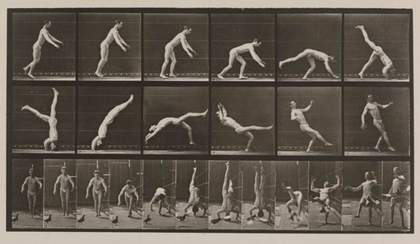
Eadweard Muybridge
Head-spring, a flying pigeon interfering. Plate 365 1887
© Corcoran Gallery of Art, Washington, DC, Museum Purchase
The albumen print became popular because it produced a rich sharp image. The process involves coating a sheet of paper with albumen (egg white), making the paper’s surface glossy and smooth. It is then coated in a solution of silver nitrate. The albumen and the silver nitrate form light-sensitive silver salts on the paper. When a glass negative is placed directly on the paper and exposed to light, it forms an image on the paper.

